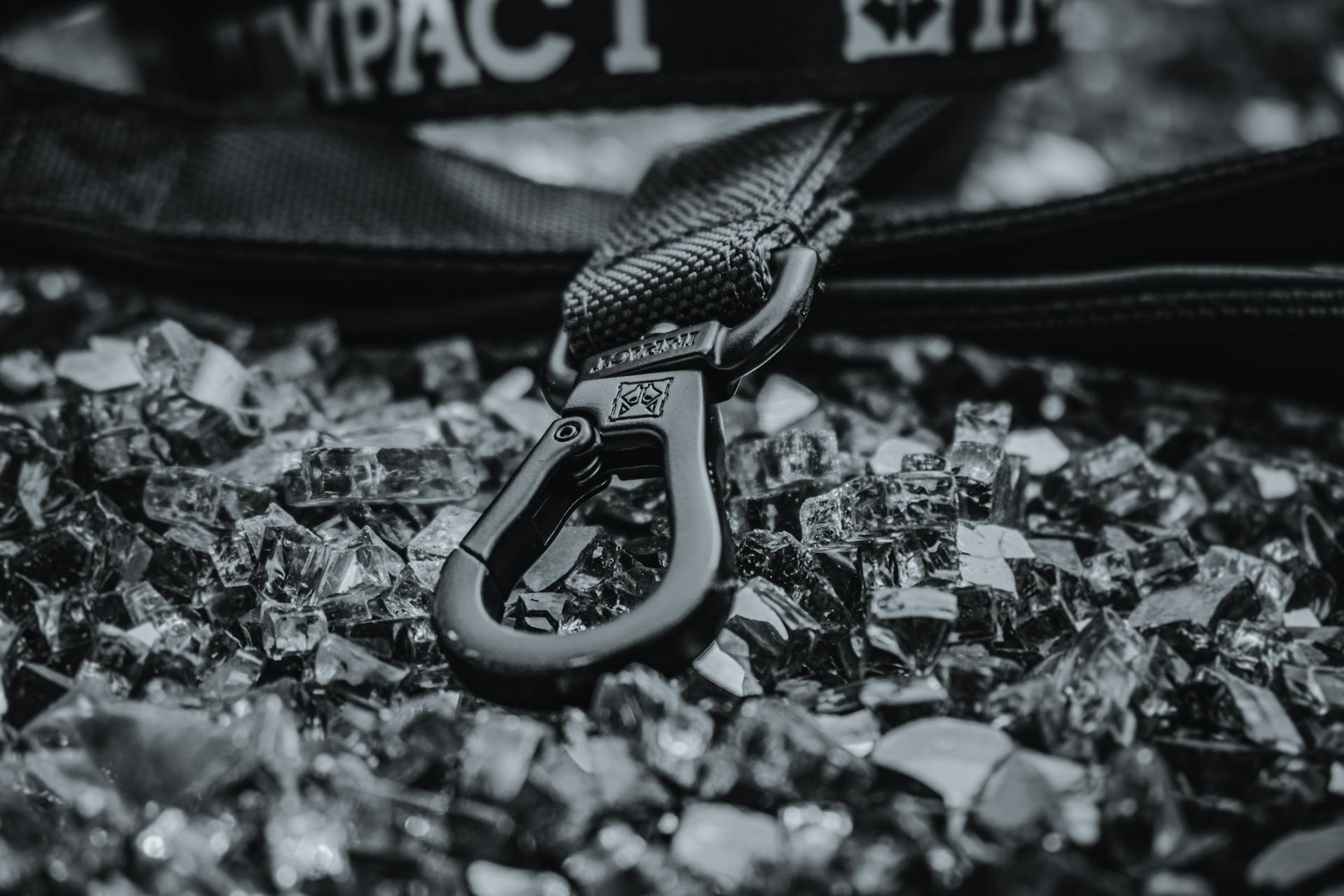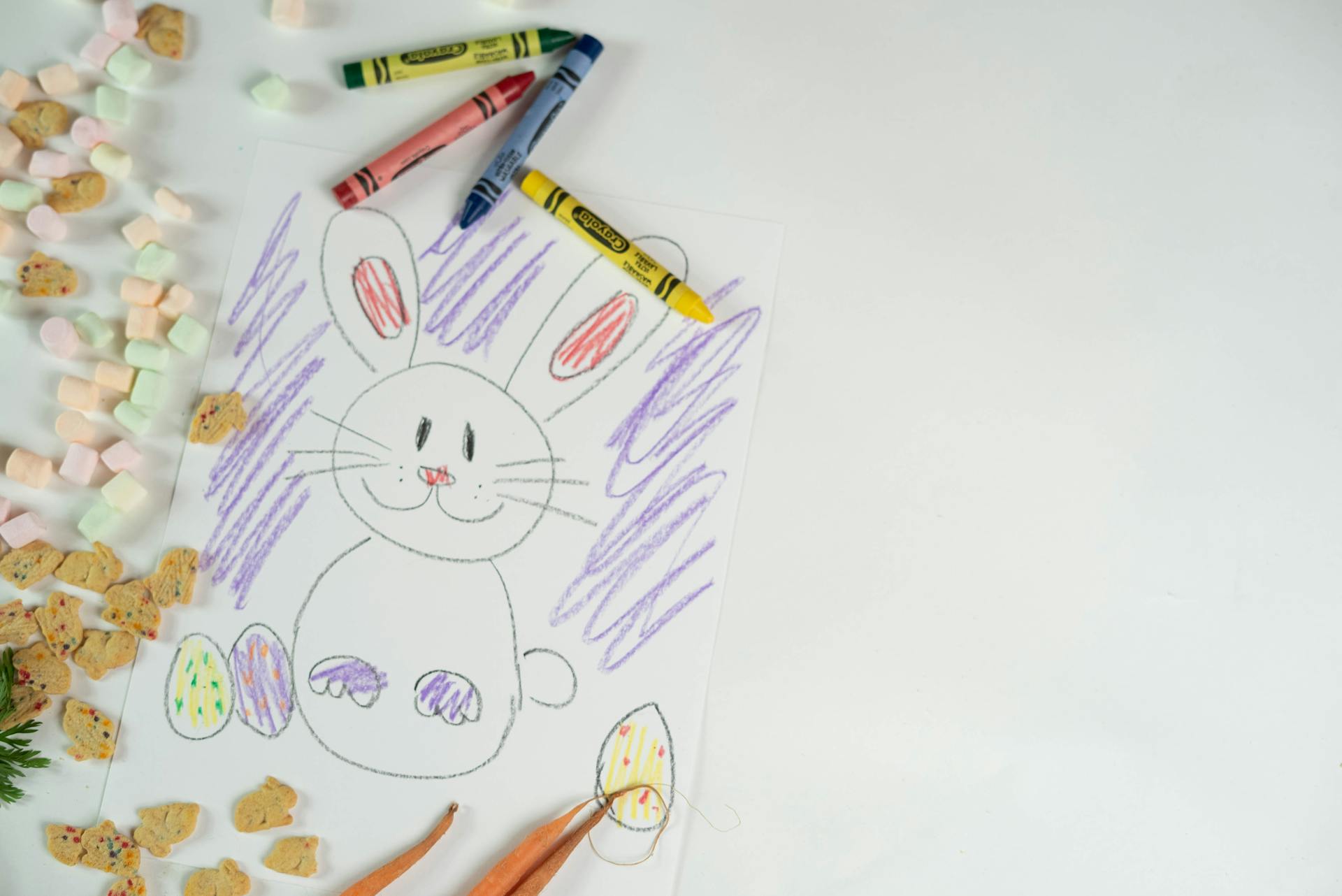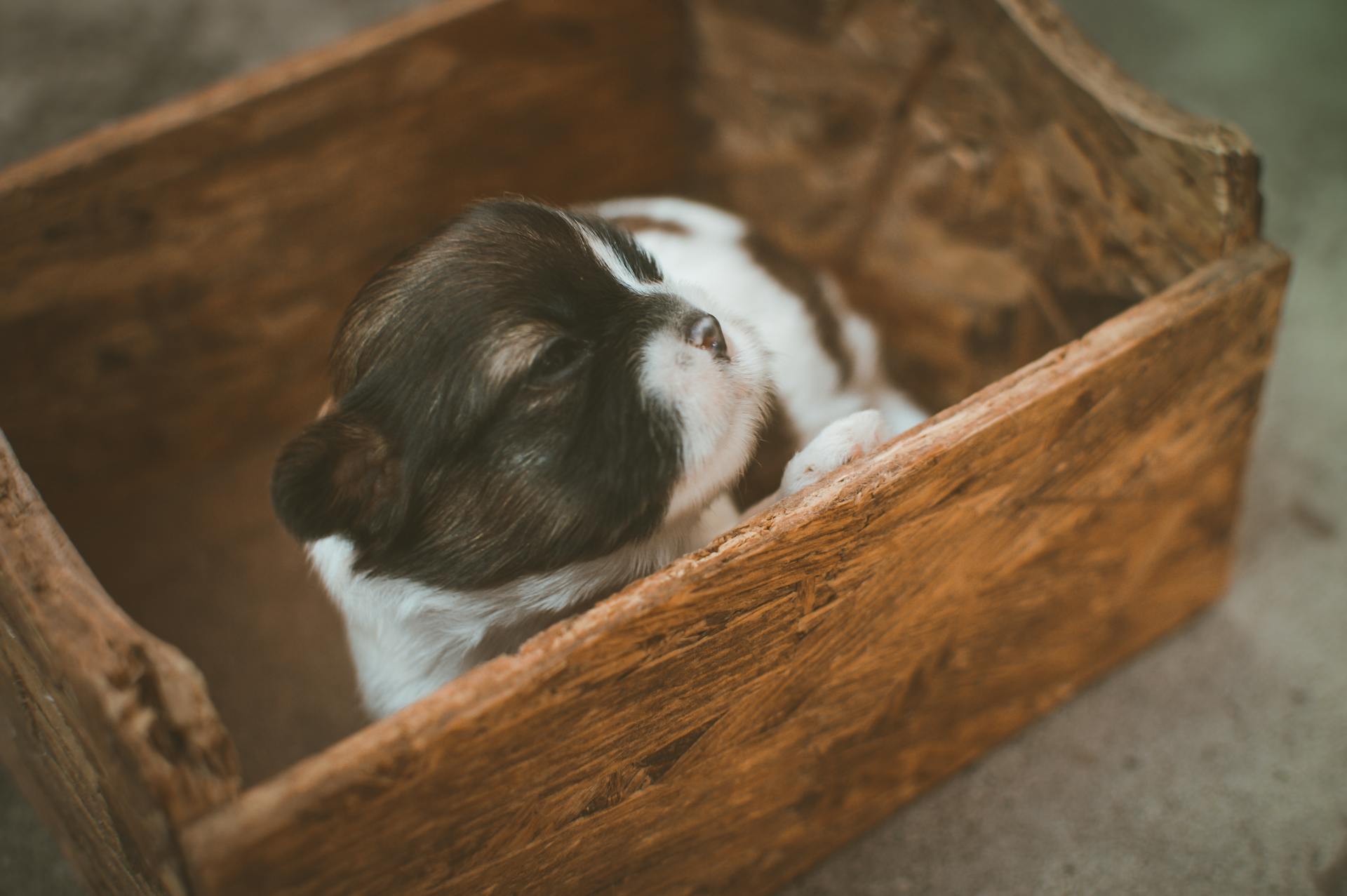
Crate training is a simple yet effective way to housetrain your dog. By introducing a crate into your dog's daily routine, you can help them learn to hold their bladder and bowels until they're taken outside.
A crate is essentially a small enclosure where your dog can safely relax and feel secure. Crate training is a great way to prevent destructive behavior, like chewing on furniture or shoes, when you're not home to supervise.
Dogs can hold their bladders for about one hour for every month of age, so a crate can be a lifesaver for new puppy owners. This means a three-month-old puppy can hold it for about three hours.
The crate should be large enough for your dog to stand up, turn around, and lie down comfortably.
Suggestion: 6 Month Old Dog Training
Understanding Crate Training
Crate training is a way to help your dog feel safe and secure in their own space. Dogs are den animals, and a crate can provide that den-like comfort.
A crate can be used for various purposes, including housetraining, emergency evacuation, traveling, and preventing destructive behaviors. Dogs don't like to soil the area they sleep in, so a crate helps puppies learn to hold their bladder for longer periods of time.
The crate should be placed in a location where your dog feels close to you, such as your bedroom or a nearby hallway. This can help your dog feel more comfortable in the crate.
To crate train your dog successfully, it's essential to never use the crate for punishment. This can create negative associations with the crate and make your dog feel anxious or stressed.
Here are some benefits of crate training:
• Provides a safe, quiet space for dogs
• Aids in housetraining
• Emergency evacuation
• Traveling
• Prevents destructive behaviors
By following these tips and understanding the importance of crate training, you can help your dog feel comfortable and secure in their own space.
You might enjoy: Will Spaying Help with Dog Aggression
Preparing Your Home
Preparing Your Home is a crucial step in crate training your dog. You'll want to choose a crate that's the right size for your dog, with enough room to stand up, turn around, and lie down comfortably.
To make your dog feel safe and secure, place the crate in a high-traffic area of your home, such as the living room or kitchen. This will help your dog get used to the crate and reduce separation anxiety.
A good rule of thumb is to crate your dog for 1-2 hours at a time, with regular breaks in between. This will help prevent boredom, anxiety, and destructive behavior.
See what others are reading: Will Neutering Help Dog Aggression
Choosing a
Choosing a crate for your dog is a crucial step in preparing your home for their arrival. You want to get one that's durable, comfortable, and flexible with whatever training you're doing.
To choose the right crate, consider the size, material, and features that will make it safe and comfortable for your dog. A sturdy crate is essential to prevent chewing and damage, while multiple entries provide easier access for both pets and pet parents.

A crate that's too big for your dog can lead to soiling and other issues, so it's essential to get a divider to adjust the space as your dog grows. You can also consider the crate's transportability, with options like wheels, collapsibility, or portability.
Here are some key features to look for in a crate:
- Sturdy: to prevent chewing and damage
- Multiple entries: for easier access
- Easy cleaning: to keep the crate clean and hygienic
- Rounded corners: to prevent injury
- Transportable: for easy movement and storage
Remember, the most important thing is to make the crate a positive place for your dog, not a punishment.
At Night
At night, it's best to crate your dog in a location where you can easily hear them if they need to go outside. Puppies often whine to be let outside in the middle of the night.
Putting the crate in your bedroom or nearby in a hallway can be helpful, especially for puppies, as you'll be able to hear them when they need to go outside. Older dogs should also be kept nearby initially to avoid associating the crate with social isolation.
For another approach, see: Training Dog to Ring Bell to Go Out

Crate your dog using your regular command and a treat, and initially, it may be a good idea to put the crate in your bedroom or nearby in a hallway. Puppies often need to go outside to eliminate during the night.
As your dog gets more comfortable being in the crate overnight, you can gradually begin to move it to the preferred location in your home.
How to Train
Crate training is a process that requires patience, consistency, and positive reinforcement. To start, place the crate in a high-traffic area of your home, such as the family room, and add a soft blanket or bed to make it inviting.
Begin by letting your dog explore the crate at their leisure, with the door open and secured. If they're not interested, try enticing them with small food treats or a favorite toy.
Drop treats just inside the door, then gradually move them further inside the crate to encourage your dog to enter. Don't force them to enter if they're hesitant.
Curious to learn more? Check out: No Treat Dog Training
This process may take just a few minutes or as long as several days, depending on your dog's personality and temperament. Reward your dog with treats and praise for calmly walking into the crate.
To make the crate a comfortable space, start feeding your dog regular meals near the crate, with the dish placed a little more toward the back each time. This will help create positive associations with the crate.
Once your dog is eating comfortably in the crate, you can close the door while they're eating, starting with short periods and gradually increasing the duration.
Here's a rough guide to help you increase the time your dog spends in the crate:
- Start with 5-10 minutes while eating
- Gradually increase to 30 minutes
- Then, leave them crated for short periods while you're home
- Finally, leave them crated for longer periods when you're away
Remember to release your dog from the crate if they whine or bark, and try leaving them for shorter periods if they become anxious. With patience and consistency, your dog will learn to love their crate and feel safe and secure in it.
Tips for Success
Crate training can be a game-changer for both you and your furry friend, but it requires patience and consistency.
To ensure crate training success, it's essential to go at your dog's pace, not the other way around. This means training in small steps and not pushing them too hard, as this can lead to negative associations with the crate.
Here are some key tips to keep in mind:
- Keep the crate in a quiet, comfortable spot, like your bedroom or a nearby hallway, to help your dog feel close to you.
- During the day, place the crate in the room where you and your family spend the most time, so your dog feels connected to you.
- Avoid using the crate for punishment, as this can create a negative experience for your dog.
- Be prepared for ups and downs, as dogs are not linear learners, and success may take around six months.
Remember, crate training is not just about confining your dog; it's about providing a safe, quiet space for them to relax and feel secure.
Feed Your Meals
Feeding your dog meals in the crate is a crucial step in creating a positive association with their new space. This can be done by placing their food dish near the crate initially, then gradually moving it further back inside the crate.
If your dog is readily entering the crate, you can place the food dish or interactive puzzle toy stuffed with food all the way at the back of the crate. However, if they remain reluctant to enter, start by placing the dish only as far inside as they will readily go without becoming fearful or anxious.
Intriguing read: Inside Dog Training
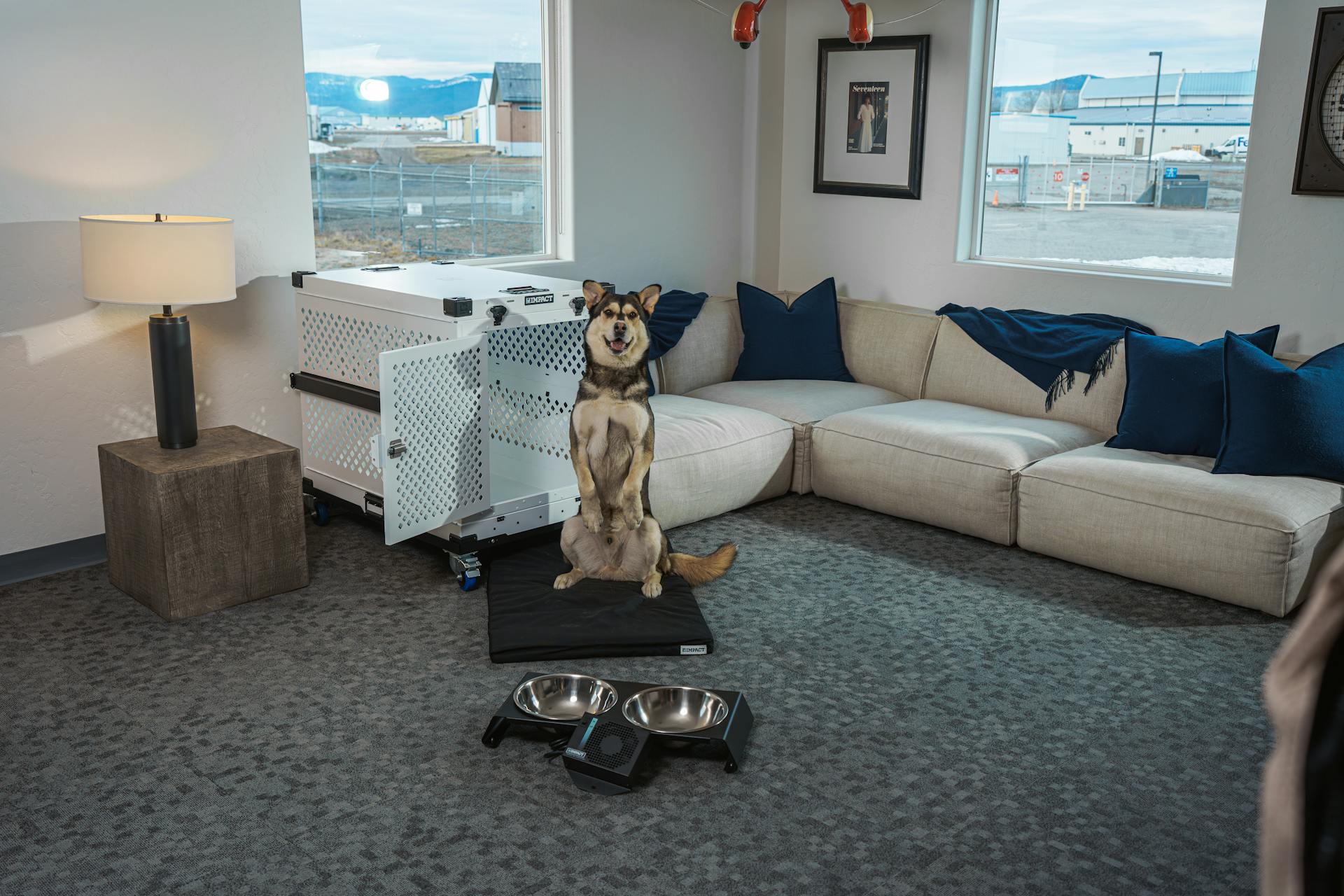
Each time you feed them, place the dish a little further back in the crate. This will help your dog become comfortable with the crate and eventually learn to stay in it for longer periods.
Here's a step-by-step guide to help you get started:
Be Patient
Crate training is a process that requires time and patience. You'll need to be prepared for at least six months of crate training, as dogs aren't linear learners and progress may not be immediate.
It's essential to stay calm and consistent in your methodology, even when it feels like you're not making progress. As Flayton advises, "as long as you stay calm and consistent in your methodology, your dog will eventually look for the reward and you'll have the opportunity to reward them."
You don't want to rush the process or expect your dog to adjust overnight. Flayton cautions against leaving your dog alone for extended periods, suggesting you start with small steps like going out for a cup of coffee and coming back to check on them.
Monitoring your dog's behavior while you're away is crucial. A remote dog camera device can help you determine if your dog is anxious, pacing, or calm, allowing you to reward them accordingly.
Worth a look: When Do Labradors Calm down
Set Up for Success

Setting up your dog for crate training success requires patience and consistency. You don't want to rush the process, so start by taking small steps, as Flayton cautions, "You don't want to go out to dinner for six hours", so begin with short periods away from your dog.
To help your dog feel comfortable in the crate, place it in a quiet area of your home, such as your bedroom or a nearby hallway. This will help your dog feel close to you and reduce anxiety.
Ideally, keep the crate in the room where you and your family spend the most time, as this will help your dog feel close to you, even when they're in their crate.
The most important thing to remember is to never use the crate as a form of punishment. This can create negative associations with the crate and make the training process more difficult.
Here's an interesting read: Shock Collar Doesn't Phase Dog
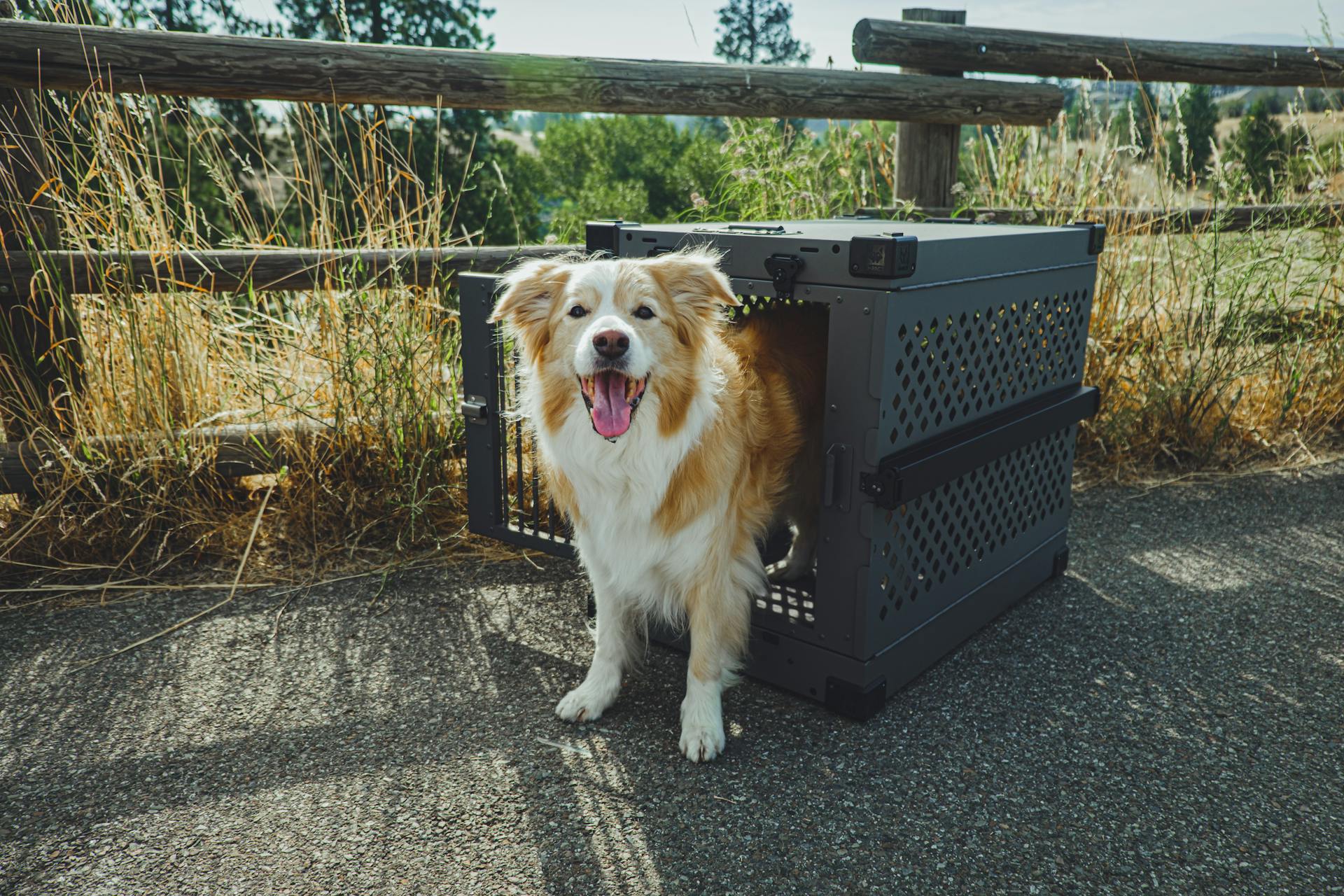
Here are some tips to keep in mind as you set up for success:
Remember, crate training is a process that requires patience and consistency. Be prepared to take things one step at a time, and don't be afraid to reward your dog for good behavior.
Your at Night
Ideally, keep the crate in your bedroom or a nearby hallway at night, especially if you have a puppy, so you can hear them when they whine to be let outside.
This helps you respond to their needs and prevents accidents. Puppies often need to go outside to eliminate during the night, and you'll want to be able to hear them when they cry.
Older dogs should also initially be kept nearby so they don't associate the crate with social isolation. Having the crate in your bedroom can also be helpful because your pup will be able to smell you and won't feel so isolated.
For another approach, see: Why Are Dachshunds so Stubborn
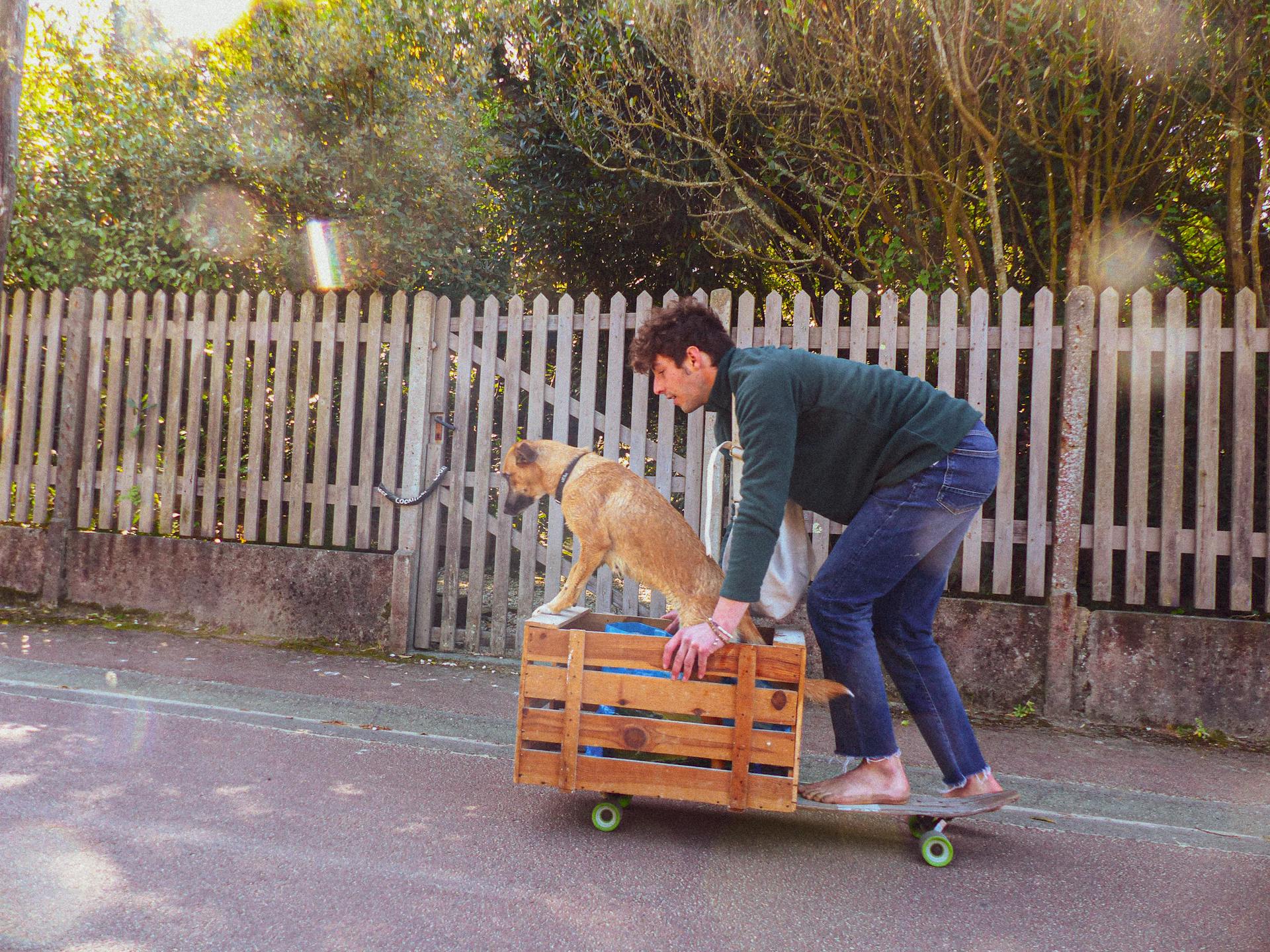
As your puppy gets more comfortable being in the crate overnight, you can gradually begin to move it to the preferred location in your home.
Here's a quick guide to help you get started:
Frequently Asked Questions
How do you know if a dog is crate trained?
A crate-trained dog remains calm and relaxed in their crate, indicating they've learned to let go of anxiety and stress. If your dog feels truly free to unwind in their crate, it's likely they've mastered crate training.
What age should you start crate training?
Crate training should start around 8 weeks of age, when your puppy leaves their mother, to help them settle quickly into their new home. Early introduction to a crate can make it a safe haven for your puppy.
Is crate training the same as potty training?
Crate training is not just for potty training, but a comprehensive training tool that extends beyond eliminating accidents. It's a versatile method that offers long-term benefits and peace of mind for dog owners.
Sources
- https://www.humanesociety.org/resources/crate-training-101
- https://dogtime.com/dog-health/general/815-crate-training-housebreaking-easy-hsus
- https://www.akc.org/expert-advice/training/how-to-crate-train-your-dog-in-9-easy-steps/
- https://www.animalhumanesociety.org/resource/crate-training-your-dog-or-puppy
- https://www.petmd.com/dog/general-health/crate-training-puppies
Featured Images: pexels.com
